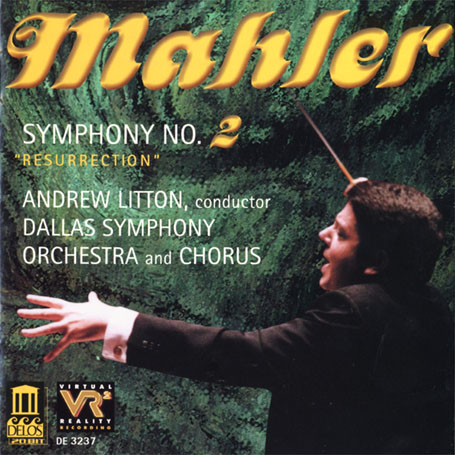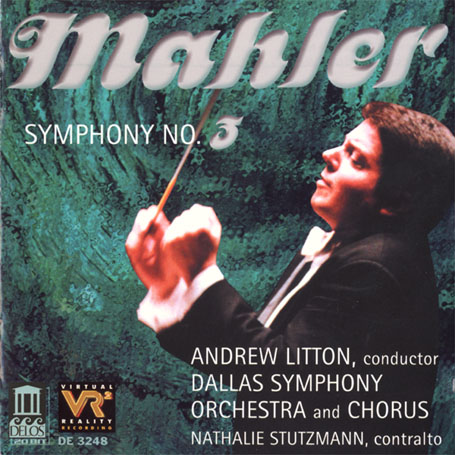Mahler Symphony No 2
Text and translation included. Live recording from the Morton H Meyerson Symphony Centre, Dallas on 14-16 May, 1998
View record and artist detailsRecord and Artist Details
Composer or Director: Gustav Mahler
Label: Delos
Magazine Review Date: 6/2000
Media Format: CD or Download
Media Runtime: 83
Mastering:
DDD
Catalogue Number: DE3237

Tracks:
| Composition | Artist Credit |
|---|---|
| Symphony No. 2, 'Resurrection' |
Gustav Mahler, Composer
Andrew Litton, Conductor Dallas Symphony Chorus Dallas Symphony Orchestra Gustav Mahler, Composer Heidi Grant Murphy, Soprano Petra Lang, Mezzo soprano |
Composer or Director: Gustav Mahler
Label: Delos
Magazine Review Date: 6/2000
Media Format: CD or Download
Media Runtime: 100
Mastering:
DDD
Catalogue Number: DE3248

Tracks:
| Composition | Artist Credit |
|---|---|
| Symphony No. 3 |
Gustav Mahler, Composer
Andrew Litton, Conductor Dallas Symphony Chorus Dallas Symphony Chorus Dallas Symphony Orchestra Gustav Mahler, Composer Nathalie Stutzmann, Contralto (Female alto) Texas Boys' Choir |
Author: David Gutman
That today's conductors should wish to record their core repertoire is, of course, perfectly understandable; that record companies should deem the results appropriate for international distribution is sometimes less so. Both these performances would draw warm applause in the concert hall (both were, indeed, recorded live, although the applause has been edited out and the audience's presence is virtually inaudible). At the same time, neither is likely to displace the versions listed above.
The Resurrection is a notoriously difficult symphony to launch - Klemperer's live Bavarian performance start with a near shambles - so Litton can hardly be blamed for erring on the side of caution. Those seismic semiquaver runs may not be exactly 'wild' as marked, but they are at least together. And while the grinding Molto pesante (track 3, 3'43'') is taken very heavily, it still lacks the wrenching agony of a Bernstein or a Rattle. One wonders why so many conductors pre-empt the shock of this by slowing up through the previous bar, as Litton does here. Nor does the last page of the movement, which the booklet-notes bizarrely describe as resolving in triumph, attempt anything so radical as Sir Simon's slow-motion nosedive.
Unfortunately, where Litton does attempt consciously to 'interpret' the music, the results can be less than convincing. The violins' quavers are pulled about (track 1, 2'58'', three bars after fig 3, and at equivalent points throughout the movement) to an extent which distorts the musical phrase. The second movement is peppered with coy little hesitations, the first of which comes as early as the eighth bar. Although these might have been convincing in concert (I have to say I have my doubts), they become increasingly irksome on repeated hearings. And should there be so much of the twig brush effect in the third movement, busking along with the woodwind (track 6, 1'16'') ? Whatever the case, the player does exactly the same later on (track 8, 0'47'' and 4'06''). Perhaps this is what Delos's annotator had in mind when he discerned 'odd shadows of Grieg's ''Anitra's Dance'' ... and even Bizet's Carmen' in this movement. The vertiginous climax doesn't produce quite the requisite frisson either here or at the start of the finale. Urlicht feels just a touch swift. A fractionally slower tempo would have allowed Petra Lang to make more of the text, although her youthful manner is undeniably appealing. Still, the final peroration seldom fails to take off: 'the stalwart power and shimmering beauty of the music is what ultimately drives home the message of love and redemption', as the booklet has it.
The Third Symphony goes better still, with beautiful sound and outstanding orchestral playing to compensate for the relatively low voltage. This is a fairly analytical Third, not unlike Salonen's, though lacking his fastidious ear for balance and textural clarification. In the fourth movement, where oboe and cor anglais decline to emulate the hinaufziehen effects attempted by their CBSO colleagues, Nathalie Stutzmann, dark-hued and uneven, seems much closer than the solo violin. Whereas the boys in the fifth movement ('one of Mahler's most successful', according to the eccentric notes) sound too distant and, surely, too reserved. The finale is rapt at the start, with more lustrous string tone than many bigger-name ensembles can muster. It is in the long first movement that I missed the presence of a Bernstein at the helm. This performance might not offer a life-changing experience, but it would be easy to live with. Bournemouth's loss has undoubtedly been Dallas's gain.
'
Discover the world's largest classical music catalogue with Presto Music.

Gramophone Digital Club
- Digital Edition
- Digital Archive
- Reviews Database
- Full website access
From £8.75 / month
Subscribe
Gramophone Full Club
- Print Edition
- Digital Edition
- Digital Archive
- Reviews Database
- Full website access
From £11.00 / month
Subscribe
If you are a library, university or other organisation that would be interested in an institutional subscription to Gramophone please click here for further information.




